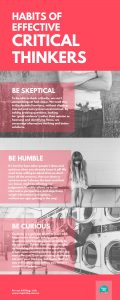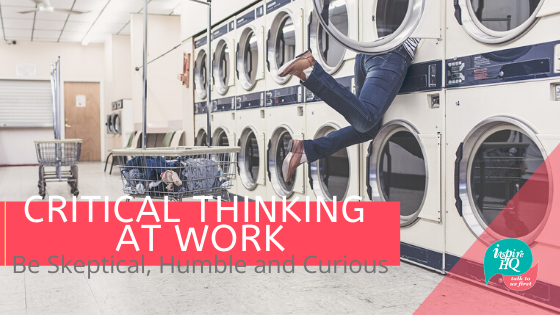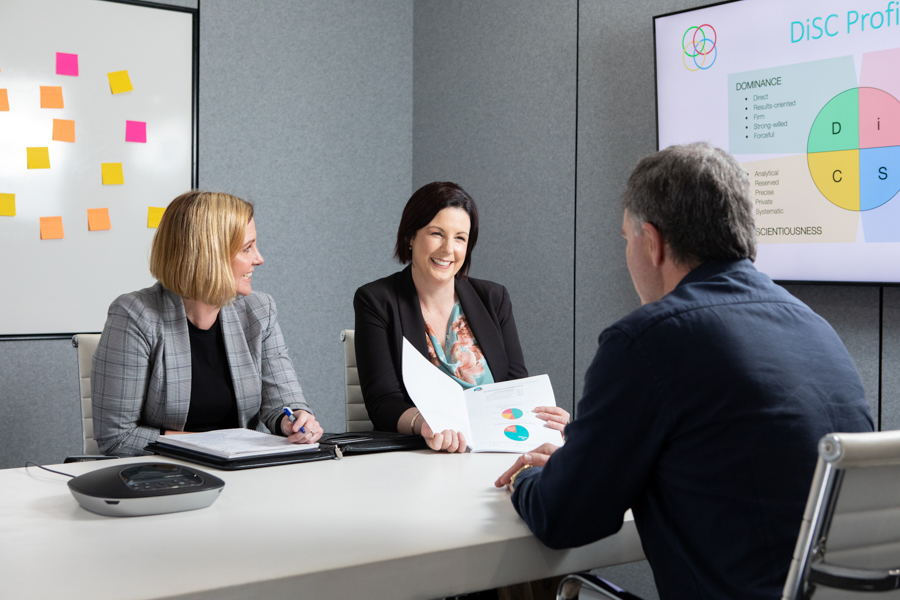As we’re hurtling through the final weeks leading into Christmas, businesses have been frantically trying to get everything done before the world ends! Sorry I meant the end of the year. I’ve recently been working with two businesses with vastly different approaches to this chaotic ‘festive’ season. One has propensity to run from one crisis to the next, relying on managers to make snap decisions to keep the juggernaut moving forward. Staff are working extra shifts, managers feel harrowed, and stress levels are high. Compare that to business two, where the deliverables are just as, if not more, complex; and the workplace is pressured by calm. Everyone knows their role, there is no sense of panic, and one of the Directors is even finishing two weeks early. Why? What’s difference? I’ve watched, listened and asked questions. There are a range of potential factors, but for me the glaring difference was the second business’ commitment to critical thinking.
Critical thinking was recently identified as one of the top 10 skills needed to stay relevant in 2020 by The World Economic Forum. Critical thinking ensures we find the best answer to a problem (and in business we have plenty of those), with maximum buy-in from everyone involved. Critical thinking saves our business’ time, money and stress.
What is critical thinking anyway?
Jen Lawrence, co-author of Engage the Fox: A Business Fable About Thinking Critically and Motivating Your Team, defines it as “the ability to solve problems effectively by systematically gathering information about an issue, generating further ideas involving a variety of perspectives, evaluating the information using logic, and making sure everyone involved in on board.”
We need to think about how we think. Critical thinking is a skill and a mindset, and in business two I see it has been so consistently applied by the leadership team, it is now second nature to all staff.
What does critical thinking look like in practice?
To build critical thinking into your every day practice requires two things, the process and the behaviours you apply. Both can be learnt, but not when you are already in a panic.
Business two rarely ‘solves’ a problem at moment it arises. They navigate their way right back to the source, engaging members of their team in the analysis and the solution finding. They see this investment in time as valuable, as it prevents hasty decisions, rework and costly mistakes. Fix it once, fix it properly.
Below is a checklist, to help you assess if you, as an individual, team or business, are showing signs of being unable to think critically:
- Signs of disorganisation in thinking or speech.
- Over-focus on details; inability to see the big picture.
- Lack of clarity about priorities.
- Inability to anticipate consequences.
- Failure to consider and articulate second and third-degree consequences of an action or decision.
- Inability to offer alternative explanations or courses of action.
- Inability to distinguish critical elements in a situation from less important ones.
- Inability to articulate thought process including the evidence used to arrive at a decision, other options that were considered and how a conclusion was reached.
- Unable to tolerate ambiguity/over-certainty.
- Difficulty outlining a step-wise process to solve a problem or implement a change.
- Thinking that is driven by emotion or ego.
Source: https://leaderonomics.com/leadership/leaders-critical-thinking-judgment
What about the behaviours of a critical thinker?
More important that the process, and the more difficult aspect to learn, is the behaviours needed to be able to think critically. By default, we are quite lazy in our thinking. We develop shortcuts and habits, based on our past experience. We also fall into the group think trap, where we avoid offering a different view in the interests of team harmony. Sometimes we’d prefer to admire or wallow in the problem rather than solve it.
We are all subject to unconscious mental processes and biases that can distort our thinking. We will never be bias-free, but we can be more vigilant in asking ourselves what are we assuming, and why are we thinking that way.
Through the research I’ve read, and my own observations, an effective critical thinker has a good mix of three main behaviours: skepticism, curiosity and humility.
Be Skeptical
This one will be the toughest for me. Whilst I wouldn’t call myself gullible, I do have a trusting nature. To be able to think critically, we can’t accept things at face value. We need stay in the doubtful territory, without slipping into out and out cynicism and mistrust. By asking probing questions, looking for ‘good evidence’ (rather than opinion or hearsay) and identifying flaws, we encourage alternative thinking and better solutions.
Be Humble
It’s hard to hear other people’s ideas and opinions when you already know it all! We need to be willing to admit that we don’t have all the answers, that our ideas or opinions aren’t always the best, and that our biases might be affecting our judgement. Humility allows us to see alternative perspectives, and objectively weigh information and options, without our egos getting in the way.
Be Curious
Curiosity is a genuine desire to learn and know more, through asking more questions and listening more carefully to the answers. Rather than getting caught up in asking the most erudite questions, simple open-ended questions are often the most effective. Your questioning challenges not only your thinking, but theirs. Both of you will explore possibilities you haven’t considered before.

Claire Huntington has over 15 years’ experience in senior and executive level human resource management and strategic leadership positions. Claire learnt HR under the wings of great mentors and through trial and error. She has a very practical hands-on approach to HR and management, and isn’t afraid to look outside the box. Claire is also mum to three school aged firecrackers and is an avid photographer in her spare time.
Disclaimer: The material contained in this publication is of a general nature only. It is not, nor is intended to be, legal advice. If you wish to act based on the content of this publication, we recommend that you seek professional advice.

